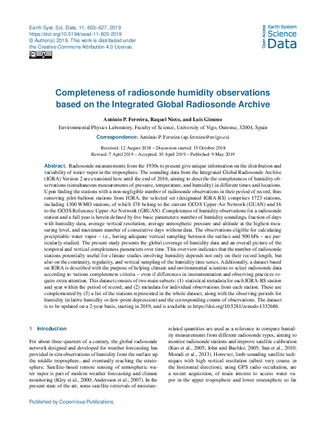
GCOS Reference Upper-Air Network
Title
Completeness of radiosonde humidity observations based on the Integrated Global Radiosonde Archive
Authors
António P. Ferreira, Raquel Nieto, and Luis Gimeno
Published
by Earth System Science Data (ESSD) at 2019-05-09
Abstract
Radiosonde measurements from the 1930s to present give unique information on the distribution and variability of water vapor in the troposphere. The sounding data from the Integrated Global Radiosonde Archive (IGRA) Version 2 are examined here until the end of 2016, aiming to describe the completeness of humidity observations (simultaneous measurements of pressure, temperature, and humidity) in different times and locations. Upon finding the stations with a non-negligible number of radiosonde observations in their period of record, thus removing pilot-balloon stations from IGRA, the selected set (designated IGRA-RS) comprises 1723 stations, including 1300 WMO stations, of which 178 belong to the current GCOS Upper-Air Network (GUAN) and 16 to the GCOS Reference Upper-Air Network (GRUAN). Completeness of humidity observations for a radiosonde station and a full year is herein defined by five basic parameters: number of humidity soundings, fraction of days with humidity data, average vertical resolution, average atmospheric pressure and altitude at the highest measuring level, and maximum number of consecutive days without data. The observations eligible for calculating precipitable water vapor – i.e., having adequate vertical sampling between the surface and 500 hPa – are particularly studied. The present study presents the global coverage of humidity data and an overall picture of the temporal and vertical completeness parameters over time. This overview indicates that the number of radiosonde stations potentially useful for climate studies involving humidity depends not only on their record length, but also on the continuity, regularity, and vertical sampling of the humidity time series. Additionally, a dataset based on IGRA is described with the purpose of helping climate and environmental scientists to select radiosonde data according to various completeness criteria – even if differences in instrumentation and observing practices require extra attention. This dataset consists of two main subsets: (1) statistical metadata for each IGRA-RS station and year within the period of record; and (2) metadata for individual observations from each station. These are complemented by (3) a list of the stations represented in the whole dataset, along with the observing periods for humidity (relative humidity or dew-point depression) and the corresponding counts of observations. The dataset is to be updated on a 2-year basis, starting in 2019, and is available at https://doi.org/10.5281/zenodo.1332686.
Citation
Ferreira, A. P., Nieto, R., and Gimeno, L.: Completeness of radiosonde humidity observations based on the Integrated Global Radiosonde Archive, Earth Syst. Sci. Data, 11, 603-627, https://doi.org/10.5194/essd-11-603-2019, 2019.
